
Carnivora is a monophyletic order of placental mammals consisting of the most recent common ancestor of all cat-like and dog-like animals, and all descendants of that ancestor. Members of this group are formally referred to as carnivorans, and have evolved to specialize in eating flesh. The order is the fifth largest order of mammals, comprising at least 279 species.

Odd-toed ungulates, mammals which constitute the taxonomic order Perissodactyla, are animals—ungulates—who have reduced the weight-bearing toes to three or one of the five original toes. The non-weight-bearing toes are either present, absent, vestigial, or positioned posteriorly. By contrast, the even-toed ungulates bear most of their weight equally on four or two of the five toes: their third and fourth toes. Another difference between the two is that odd-toed ungulates digest plant cellulose in their intestines rather than in one or more stomach chambers as even-toed ungulates, with the exception of Suina, do.
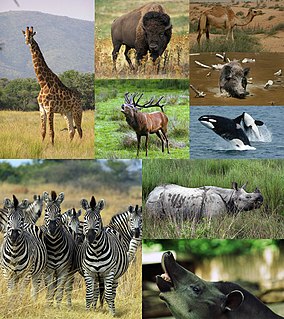
Ungulates are members of the diverse clade Ungulata which primarily consists of large mammals with hooves. These include odd-toed ungulates such as horses, rhinoceroses, and tapirs; and even-toed ungulates such as cattle, pigs, giraffes, camels, sheep, deer, and hippopotamuses. Cetaceans such as whales, dolphins, and porpoises are also classified as even-toed ungulates, although they do not have hooves. Most terrestrial ungulates use the hoofed tips of their toes to support their body weight while standing or moving.

Placental mammals are one of the three extant subdivisions of the class of animals Mammalia; the other two are Monotremata and Marsupialia. Placentalia contains the vast majority of extant mammals. Placentals are partly distinguished from other mammals in that the fetus is carried in the uterus of its mother to a relatively late stage of development. The name is something of a misnomer considering that marsupials also nourish their fetuses via a placenta, though for a relatively briefer period, giving birth to less developed young who are then kept for a period in the mother's pouch.

Afrotheria is a clade of mammals, the living members of which belong to groups that are either currently living in Africa or of African origin: golden moles, elephant shrews, tenrecs, aardvarks, hyraxes, elephants, sea cows, and several extinct clades. Most groups of afrotheres share little or no superficial resemblance, and their similarities have only become known in recent times because of genetics and molecular studies. Many afrothere groups are found mostly or exclusively in Africa, reflecting the fact that Africa was an island continent from the Cretaceous until the early Miocene around 20 million years ago, when Afro-Arabia collided with Eurasia.

Euarchontoglires is a clade and a superorder of mammals, the living members of which belong to one of the five following groups: rodents, lagomorphs, treeshrews, colugos, and primates.
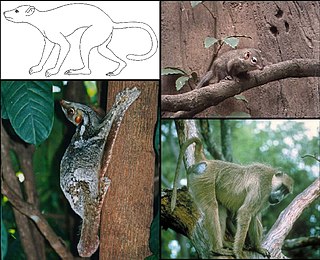
The Euarchonta are a proposed grandorder of mammals: the order Scandentia (treeshrews), and its sister Primatomorpha mirorder, containing the Dermoptera or colugos and the primates.
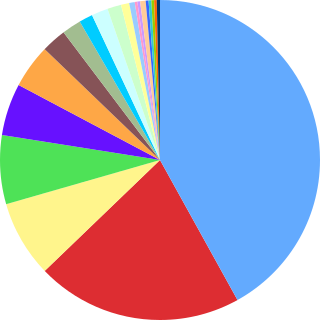
Mammalia is a class of animal within the phylum Chordata. Mammal classification has been through several iterations since Carl Linnaeus initially defined the class. No classification system is universally accepted; McKenna & Bell (1997) and Wilson & Reader (2005) provide useful recent compendiums. Many earlier ideas from Linnaeus et al. have been completely abandoned by modern taxonomists, among these are the idea that bats are related to birds or that humans represent a group outside of other living things. Competing ideas about the relationships of mammal orders do persist and are currently in development. Most significantly in recent years, cladistic thinking has led to an effort to ensure that all taxonomic designations represent monophyletic groups. The field has also seen a recent surge in interest and modification due to the results of molecular phylogenetics.

Laurasiatheria is a superorder of placental mammals that groups together hedgehogs (eulipotyphlans), bats (chiropterans), cats and dogs (carnivores), pangolins (pholidotes), cows and whales (cetartiodactyls), horses (perissodactyls), and all their extant and extinct relatives. From systematics and phylogenetic perspectives, it is subdivided into order Eulipotyphla and clade Scrotifera. It is a sister group to Euarchontoglires with which it forms the magnorder Boreoeutheria. Laurasiatheria was discovered on the basis of the similar gene sequences shared by the mammals belonging to it; no anatomical features have yet been found that unite the group. The Laurasiatheria clade is based on DNA sequence analyses and retrotransposon presence/absence data. The superorder originated on the northern supercontinent of Laurasia, after it split from Gondwana when Pangaea broke up. Its last common ancestor is supposed to have diversified ca. 76 to 90 million years ago.
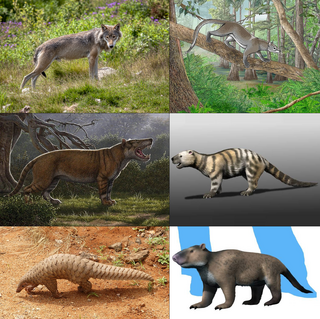
Ferae is a mirorder of placental mammals that groups together clades Pan-Carnivora and Pholidotamorpha. The Ferae is a sister group to the clade Pan-Euungulata and together they make grandorder Ferungulata.

Atlantogenata is a proposed clade of mammals containing the cohorts or superorders Xenarthra and Afrotheria. These groups originated and radiated in the South American and African continents, respectively, presumably in the Cretaceous. Together with Boreoeutheria, they make up Eutheria. The monophyly of this grouping was supported by some genetic evidence.

Zooamata is a proposal for a clade of mammals uniting the Ferae with the Perissodactyla.
Retrotransposon markers are components of DNA which are used as cladistic markers. They assist in determining the common ancestry, or not, of related taxa. The "presence" of a given retrotransposon in related taxa suggests their orthologous integration, a derived condition acquired via a common ancestry, while the "absence" of particular elements indicates the plesiomorphic condition prior to integration in more distant taxa. The use of presence/absence analyses to reconstruct the systematic biology of mammals depends on the availability of retrotransposons that were actively integrating before the divergence of a particular species.

Boreoeutheria is a magnorder of placental mammals that groups together superorders Euarchontoglires and Laurasiatheria. With a few exceptions male animals in the clade have a scrotum, an ancestral feature of the clade. The sub-clade Scrotifera was named after this feature.
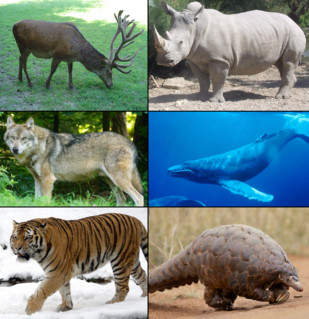
Ferungulata is a grandorder of placental mammals that groups together mirorder Ferae and clade Pan-Euungulata. It has existed in two guises, a traditional one based on morphological analysis and a revised one taking into account more recent molecular analyses. The Fereungulata is a sister group to the order Chiroptera (bats) and together they make clade Scrotifera.

Carnivoramorpha is a clade of placental mammals that includes the modern order Carnivora and its extinct stem-relatives.

Whippomorpha or Cetancodonta is a group of animals that contains all living cetaceans and hippopotamuses, as well as their extinct relatives, i.e. Entelodonts and Andrewsarchus. All Whippomorphs are descendants of the last common ancestor of Hippopotamus amphibius and Tursiops truncatus. This makes it a crown group. Whippomorpha is a suborder within the order Artiodactyla. The placement of Whippomorpha within Artiodactyla is a matter of some contention, as hippopotamuses were previously considered to be more closely related to Suidae (pigs) and Tayassuidae (peccaries). Most contemporary scientific phylogenetic and morphological research studies link hippopotamuses with cetaceans, and genetic evidence has overwhelmingly supported an evolutionary relationship between Hippopotamidae and Cetacea. Modern Whippomorphs all share a number of behavioural and physiological traits; such as a dense layer of subcutaneous fat and largely hairless bodies. They exhibit amphibious and aquatic behaviors and possess similar auditory structures.

Artiofabula is a clade made up of the Suina and the Cetruminantia. The clade was found in molecular phylogenetic analyses and contradicted traditional relationships based on morphological analyses.
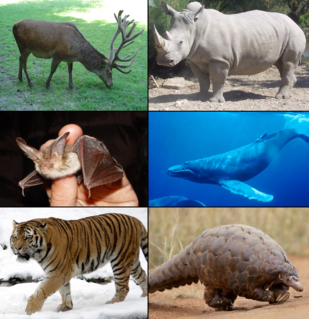
Scrotifera is a clade of placental mammals that groups together order Chiroptera and grandorder Ferungulata, and their common ancestors. The clade Scrotifera is a sister group to the order Eulipotyphla based on evidence from molecular phylogenetics, and together they make superorder Laurasiatheria. The last common ancestor of Scrotifera is supposed to have diversified ca. 73.1 to 85.5 million years ago.

Pholidotamorpha ("pangolin-shaped") is a clade of mammals that includes the orders Palaeanodonta and Pholidota.

















